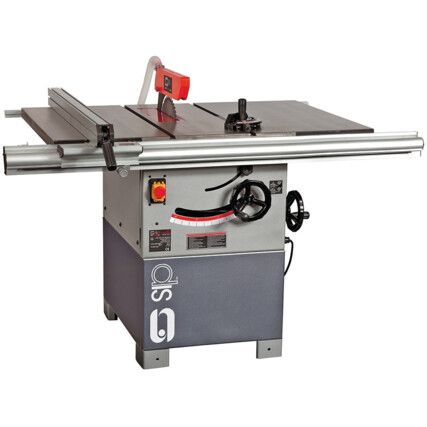Table Saws
For power and precision, we stock a wide range of table saws, both portable and stationary. Made with heavy-duty materials, our professional quality table saws are carefully chosen from market-leading brands, like Evolution Power Tools®, DeWalt® and SIP®.
What are table saws?
Central to a woodworker's toolkit, a table saw features a metal bench with an integrated saw blade which is driven by a motor. Suitable for all kinds of cuts, the blade is adjustable in height and angle, while an adjustable fence keeps the workpiece straight to maintain accuracy.
When are table saws used?
Table saws are used to make accurate cuts including rip cuts, cross cuts and mitre and bevel cuts to wood. They're used widely by woodworking professionals, including furniture and cabinet makers and kitchen fitters.
Table saw types
Table saws are broken down into two different types: portable and stationary. Portable types of table saw are designed for lighter cuts on smaller bits of wood. Whereas a stationary saw is more likely to appear in a professional woodworker's shop.
• Portable bench top table saw - Lightweight and compact, this low-powered version suitable for very lightweight tasks
• Compact table saw - A more powerful version of the benchtop saw, this portable and compact table saw is ideal for heavier duty tasks
• Portable jobsite table saw - Supplied with a portable stand and extendable rip capacity among other handy features, this table saw variant is a good choice when working on-site and moving between locations
• Contractor table saw - A smaller variant of a cabinet saw, this high-powered saw is economically priced and ideal if you can't afford a cabinet version
• Cabinet table saw - Non-portable; these large saws feature the motor and controls in a cabinet the sits below the saw table. They're a powerful saw designed for professionals and can cut through all kinds of wood
• Hybrid table saw - Similar to a cabinet saw, an enclosed motor is positioned below the table, however, these saws are smaller and not as powerful as a cabinet saw
Considerations when choosing a table saw
• Project size - for frequent and large-scale projects, a larger and more powerful saw is the right choice. Occasional use for smaller projects requires a smaller tabletop version.
• Fence - a good fence will deliver straight and accurate cuts over the lifetime of the saw and is considered to be one of the best investments when upgrading a table saw.
• Guards - blade guards are extremely important for preventing kickback and other serious injuries. If you feel that you can't work with a blade guard, a riving knife is a good alternative, sitting behind the blade and taking any pressure applied by the workpiece away from the blade.
• Safety - always wear safety goggles or safety glasses when using your table saw to protect against any flying debris. It's also a good idea to protect your hearing with some earplugs or ear protectors. We also recommend a dust mask to protect against wood dust.
Table saw jargon buster
To keep you up to date with woodworking terms we've put together a comprehensive list of woodworking definitions used frequently when using a table saw.
• Rip cuts - cuts with the grain. These types of cuts use a rip blade with FTG teeth. The teeth feature ground flat edges that enable effective cutting with the grain
• Cross cuts - These cuts are made across the grain. A combination blade or general-purpose blade is ideal for this purpose with teeth that feature some sharp edges on the teeth and some flat edges
• Mitre cuts - This is an angled cut across the face of a workpiece, like a door frame. Most mitre cuts are made across the grain, so a cross cut blade is a good option. A mitre gauge is a really handy tool to get accurate mitre cuts
• Bevel cuts - These are angled cuts made to the end of a workpiece (an end bevel) or the edge of a workpiece (edge bevel). A digital angle device is another handy tool to achieve maximum accuracy
• Auxiliary fence - This is an extra fence usually made with a spare piece of hardwood. It's used to maintain a straight edge from which to push your workpiece toward the saw blade
• Tear-out - This is where the saw blade teeth exit the workpiece and leave unsightly shredded wood fibres. This is usually an issue when performing cross cuts
FAQs
What are the biggest dangers when using a table saw?
The most dangerous part of a table saw is its blade for many reasons. The obvious one is the blades' ability to cut fingers from hands when it's in motion. However, it can also create kickback on a workpiece. This happens when each side of a piece of wood being cut puts pressure on the blade's teeth. This force is expelled without warning and propels the loose off cut back at the operator at a speed that- can cause a serious injury.
What's the difference between a circular saw and a table saw?
A circular saw is a compact and portable power saw that can be quickly adjusted to make cross and mitre cuts. A table saw uses the same shaped blade as a circular saw, but it is fully adjustable and can cut large and complex cuts required for precise applications.
